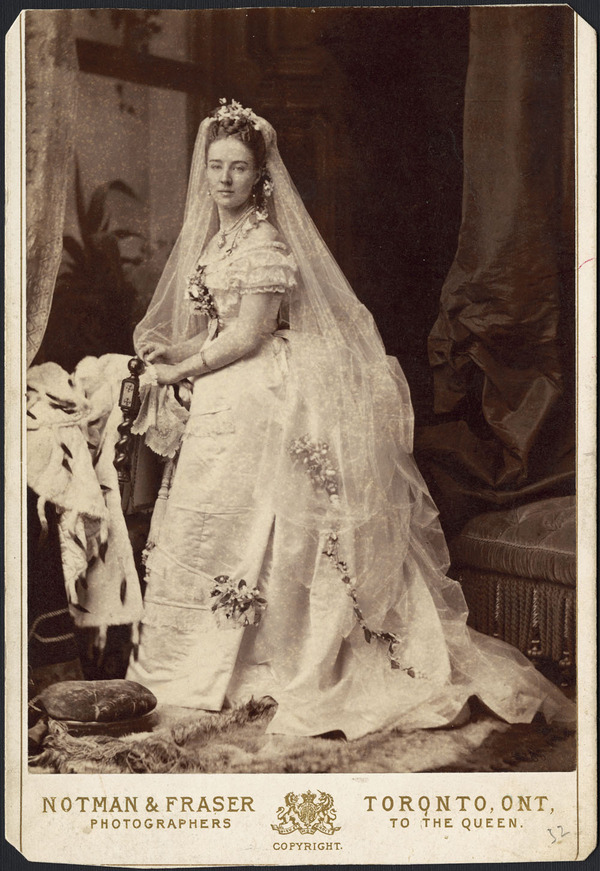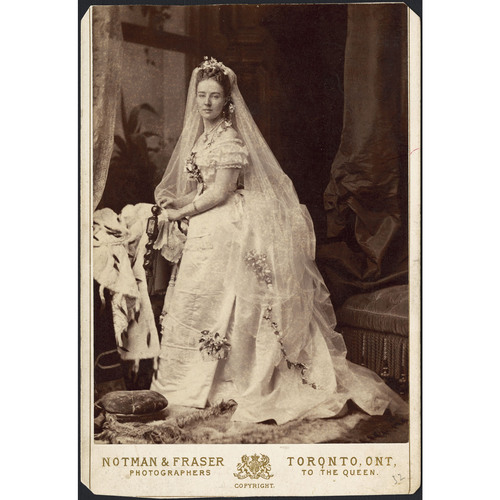BOULTON, EDITH SARAH LOUISA (Nordheimer), philanthropist and imperialist; b. 1847 in Toronto and baptized 3 May 1847 in Niagara (Niagara-on-the-Lake), Upper Canada, daughter of James Boulton and Margaret Neilina Fortye; m. 15 Nov. 1871 Samuel Nordheimer in Toronto, and they had eight daughters and three sons; d. there 14 Nov. 1912.
A barrister in Niagara, James Boulton moved his practice to Toronto about the time of Edith Boulton’s birth. At the age of 24 she married 42-year-old Samuel Nordheimer, co-founder with his brother Abraham* of a music company and later a German consul in Ontario. As the daughter of a prominent Toronto family – her grandfather D’Arcy Boulton* had been an attorney general – and the wife of a prosperous and well-known businessman, Edith Nordheimer soon occupied an élite position in Toronto society. She entertained at her lavish suburban home on Davenport Road, Glenedyth, and attended exclusive social functions. On a trip to England in 1873, she was presented to Queen Victoria. Like many upper- and middle-class women of the late 19th century, she was also involved in a variety of philanthropic organizations. An Anglican, she contributed in Toronto to the Infants’ Home, the Hillcrest Convalescent Hospital, the Ladies’ Work Depository, the Working Boys’ Home, the Children’s Aid Society, and St James’ Cathedral, and she was a governor of the Ottawa-based Victorian Order of Nurses.
As her children grew up, Edith Nordheimer’s involvement increased. During the South African War she served as president of the women’s branch of the Red Cross Society and in 1905 she promoted the founding of the Female Immigrants Receiving Home in Toronto. However, it was as president of the Imperial Order Daughters of the Empire that she became most influential. Turn-of-the-century supporters of imperialism in Canada promoted closer ties with Britain, as well as the upholding of what they deemed the superior moral attributes of the Anglo-Saxon race. Women in English-speaking Canada organized to support this vision in a variety of ways, but it was the IODE which became the most prominent women’s voice for imperialism.
The Federation of the Daughters of the Empire had been officially founded in Montreal in 1900 by Margaret Smith Murray [Polson*]. A year later, however, a group of Ontario women re-established the order in Toronto with Nordheimer as president and altered its name slightly. The reasons for the relocation are unclear, though the minutes of the Toronto executive would later refer to the “Montreal complications,” “the entirely unbusinesslike procedures from the first,” and the need for legal advice on the move.
Under Nordheimer, the IODE attempted to promote the connections between Canada and the empire, and the British nature of Canada, by forging contacts with women in other colonies and by increasing Canadians’ knowledge of the empire. To these ends the IODE endeavoured to establish branches throughout the empire, produced educational materials, sponsored essay contests, promoted holidays commemorating imperial history, provided for the maintenance of war graves, and established memorials to imperial heroes and heroines, including Canadians who had fought in the South African War. Nordheimer’s special interest in this last project was reflected in her vice-presidency, beginning in 1904, of the Toronto South African Memorial Association.
Like many other women’s reform and philanthropic organizations of the time, the IODE used the language of the home to articulate its vision. In 1908 Nordheimer described the empire as “one great family” and entreated women to think of themselves as “part of that wonderful household.” Moreover, she saw the mission of the IODE to be the promotion and protection of Anglo-Saxon values in Canada through the teaching of “children that British ideals are best for their descendants.” Although the IODE used many means to propagate these ideals, Nordheimer emphasized the importance of domestic duty. She stressed that, as mothers and keepers of the home, women bore much of the responsibility for the future character of Canada and the empire. Upon her retirement as president in 1911, she reminded the order’s members that “it is the home influence that tells in the bringing up of your country’s children – use it then for your God, your King, your country.” At the same time she asked for a commitment to the IODE equal to her own level of devotion: “Make your membership . . . a sacred part of your life.”
Under Nordheimer the IODE grew into a thriving organization of about 10,000 members with dozens of chapters across Canada. There were even scattered chapters in the United States, the Bahamas, Bermuda, Newfoundland, and India, although Nordheimer’s goal of an empire-wide organization was never realized. According to her contemporaries, she was a skilled organizer who devoted tremendous energy to the order. After her death, one colleague remarked that the IODE “was her very life” and that “she was more like the ruler of an empire than the president of a society.” This comment was given in admiration, but it suggests that at times Nordheimer’s dedication led to an autocratic style of leadership. In fact, her tenure was not without controversy. Nordheimer and her executive tightly controlled the activities of IODE chapters, and in 1909 a conflict over the design of a statue led to the temporary expulsion of the municipal chapter in London, Ont. Two years later she led a delegation of the IODE to England to attend the coronation of George V and to meet with members of the IODE’s sister organization, the Victoria League. It was dissatisfaction over her handling of the trip that led to her resignation late in 1911 and to reorganization of the executive. She was given the honorary title of patroness of the order at its annual meeting on 30 May 1912.
Shortly before her death, in recognition of her public service, King George sanctioned her appointment as a lady of grace of the Order of St John of Jerusalem in England. Edith Nordheimer died suddenly in November 1912, only a year after giving up the leadership of the organization to which she had been so vital. Survived by a son and seven daughters, she was buried on the grounds of Glenedyth.
AO, F 978, MS 545, St Mark’s Anglican Church, Niagara [Niagara-on-the-Lake, Ont.], RBMB, 3 May 1847 (mfm.); RG 22-305, nos.25958, 27802; RG 80-2; RG 80-3; RG 80-5-0-29, vol.28: f.59. NA, MG 28, 117, vols.1–2. Globe, 16 Nov. 1871, 15 Nov. 1912. Toronto Daily Star, 15 Nov. 1912. World (Toronto), 15 Nov. 1912. Canadian men and women of the time (Morgan; 1912). Cyclopædia of Canadian biog. (Rose and Charlesworth), vol.1. Echoes (Toronto), president’s annual address, June 1908, June 1909 (IODE journal; copies available in NA, Library). N. M. Sheehan, “The IODE, the schools and World War I,” Hist. of Education Rev. (Bedford Park, Australia), 13 (1984), no.1: 29–44; “Philosophy, pedagogy, and practice: the IODE and the schools in Canada, 1900–1945,” Hist. Studies in Education (London, Ont.), 2 (1990): 307–21. Types of Canadian women . . . , ed. H. J. Morgan (Toronto, 1903).
Cite This Article
Tori Smith, “BOULTON, EDITH SARAH LOUISA (Nordheimer),” in Dictionary of Canadian Biography, vol. 14, University of Toronto/Université Laval, 2003–, accessed April 12, 2025, https://www.biographi.ca/en/bio/boulton_edith_sarah_louisa_14E.html.
The citation above shows the format for footnotes and endnotes according to the Chicago manual of style (16th edition). Information to be used in other citation formats:
| Permalink: | https://www.biographi.ca/en/bio/boulton_edith_sarah_louisa_14E.html |
| Author of Article: | Tori Smith |
| Title of Article: | BOULTON, EDITH SARAH LOUISA (Nordheimer) |
| Publication Name: | Dictionary of Canadian Biography, vol. 14 |
| Publisher: | University of Toronto/Université Laval |
| Year of revision: | 1998 |
| Access Date: | April 12, 2025 |




